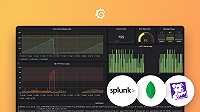Atlassian Statuspage Grafana data source
Note
Atlassian Statuspage enterprise data source for Grafana is currently in public preview. Grafana Labs offers limited support, and breaking changes might occur prior to the feature being made generally available.
The Atlassian Statuspage data source plugin allows you to query operational status of your page, incidents, scheduled maintenances for your Atlassian Statuspage.
Requirements
This plugin has the following requirements:
- Working Atlassian Statuspage
- Any free or paid Grafana Cloud plan or an activated on-prem Grafana Enterprise license. Contracted Cloud customers should refer to their agreement.
Install the data source
To install the data source, refer to Installation.
Configure the data source in Grafana
Add a data source by filling in the following information:
Connection
URL
This is your Atlassian Statuspage URL. You should include protocol (e.g. https://) and remove the trailing /. You can find some examples below.
Authentication
Authentication is not required for this data source. Any public Atlassian Statuspage can be used.
Configure the data source with provisioning
It is possible to configure data sources using configuration files with Grafana’s provisioning system. To read about how it works refer to Provisioning Grafana data sources.
Here is the provisioning example for this data source using API token authentication:
apiVersion: 1
datasources:
- name: Atlassian Statuspage
type: grafana-atlassianstatuspage-datasource
jsonData:
variables:
url: <YOUR_ATLASSIAN_STATUSPAGE_URL>Query the data source
Plugin allows querying Summary, Status, Components, Unresolved incidents, All incidents, Upcoming scheduled maintenances, Active scheduled maintenances, All scheduled maintenances.
Querying Status data
Status query shows operational status of your page
Querying Summary data
Get the status rollup for the whole page. This endpoint includes an indicator - one of none, minor, major, or critical, as well as a human description of the blended component status. Examples of the blended status include “All Systems Operational”, “Partial System Outage”, and “Major Service Outage”.
Querying components data
Get the components for the page. Each component is listed along with its status - one of operational, degraded_performance, partial_outage, or major_outage.
Querying Unresolved incidents data
Get a list of any unresolved incidents. This endpoint will only return incidents in the Investigating, Identified, or Monitoring state.
Querying All incidents data
Get a list of the 50 most recent incidents. This includes all unresolved incidents as described above, as well as those in the Resolved and Postmortem state.
Querying Upcoming scheduled maintenances data
Get a list of any upcoming maintenances. This endpoint will only return scheduled maintenances still in the Scheduled state.
Active scheduled maintenances data
Get a list of any active maintenances. This endpoint will only return scheduled maintenances in the In Progress or Verifying state.
All scheduled maintenances data
Get a list of the 50 most recent scheduled maintenances. This includes scheduled maintenances as described in the above two endpoints, as well as those in the Completed state.
Annotations
You can use annotations to visualize the relation between Atlassian Statuspage data and other data on your dashboards. For a generic information on how to use annotations refer to the documentation.
Known limitations
IncidentsandMaintenancesaction currently only returns maximum 50 latest records.- At the moment plugin doesn’t support alerting.
Learn more
- Add Transformations.



